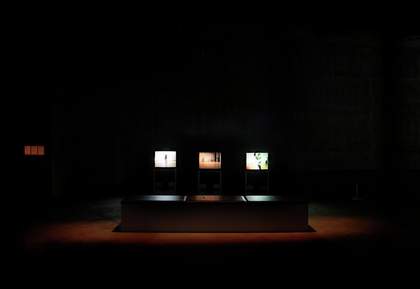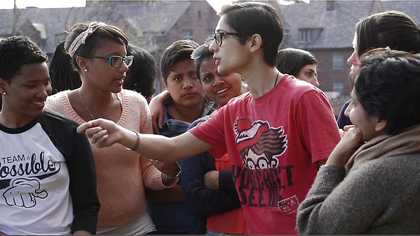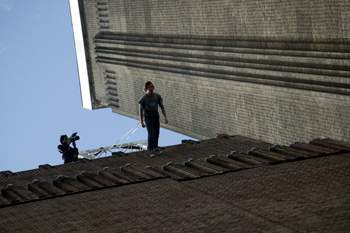A little like proverbial trees falling in forests, does art speak if no-one is around to hear it?
I think it is quite rare to think about how art speaks. Perhaps we think we are doing it all the time when we look at, talk about, write about art. Over the years, however, I found I was doing something entirely different. Rather than thinking about how art speaks, I was thinking about how to speak about art. Of course, the two overlap. Slipping and sliding over each other until I find it impossible to think about one without the other. But they are not the same. After sitting with these questions for a few months, I realised that thinking about how art speaks is actually incredibly freeing. There is no reason to be self-conscious when thinking about how art speaks, no particular need to have done the reading or read the reviews. Doing these things may alter how art speaks to you, in positive and negative ways. But, even without them, the conversations you can have with art can be deep, personal, frivolous, intimate. And they will be influenced by who you are and who you’re with, where the art is displayed and how long it’s been since lunch.
In the past, I focused too much on how to speak about art. I tried to convey through my writing what I thought art was saying ‘generally’. Tried to imagine what other people might want me to say about it. I was scared to honestly recount the conversations I was having with art in case the way art spoke to me was ‘wrong’ or perhaps revealed too much. This text offers some ways that art might speak to you and some ways it has spoken to me, but, as ever, the best way to hear what art has to say is by listening, looking, participating and imagining.
Lyle Ashton Harris
Speaking Through Photography
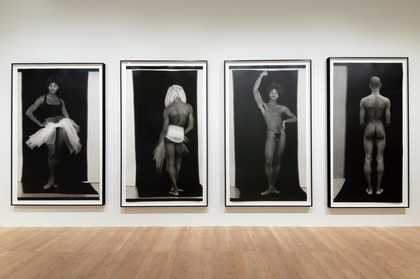
Lyle Ashton Harris
Constructs #10 - #13 (1989)
Tate
I’m standing in Tate Modern in front of Constructs #10 - #13 (1989), Lyle Ashton Harris’s series of four black and white self-portraits. I look up and unexpectedly catch his eye in the photograph on the far left. He looks straight back at me, assertive in his netted tutu and ballet pose. Even when facing away from me in the second photograph, I feel like he is in control of the conversation. He appears to communicate his attitude through the sway of his hip, his tousled wig, and the netted material that barely covers his behind. He seems at ease, confident in front of the camera. But the last in the series is different. This time, instead of him choosing to turn away, it feels as though I’m the one who has decided to watch him from behind. The power has shifted to me, as his body shows none of the attitude marked by clothes or pose so evident in the other photographs. He doesn’t speak to me and instead I am left to project onto him, almost a blank canvas.
Across the four photographs, Harris plays with the language of classical sculpture and ballet: art forms with high cultural value. But, as a gay Black man making this work at the height of the AIDS pandemic, he subverts this language of established power. Harris has described the photographs as “almost an aggressive assertion of sex positiveness” and “a tool for embodiment to reimagine the self [...] and rethink our understanding of identity.” Made while he was still a student in California, the series has become some of his most celebrated work, included in exhibitions such as Black Male: Representations of Masculinity in Contemporary American Art curated by Thelma Golden in 1994 at the Whitney Museum of American Art. In a conversation with artist and writer Morgan Quaintance, Harris described how his work and the Whitney exhibition made a lasting impact on many who saw it at a time when Black and queer identities were not very visible in mainstream art spaces.
The great [artist] Kehinde Wiley said it was seeing that work at the Whitney, Thelma Golden's landmark show, that did something for him in terms of speaking about the possibility of gender. Or the curator of media at MoMA, Thomas Lax, my dear friend, who said seeing that work as a teenager, it resonated and it caused a rupture in terms of his thinking.
Lyle Ashton Harris in conversation with artist and writer Morgan Quaintance at a Tate event
Harris’s art is both the product and creator of many conversations between artists and artworkers and this is integral to how he speaks about his art and career. His work forms part of a dialogue between a network of Black creatives and thinkers, including filmmakers, artists, poets and theorists, many of whom he first met when they were visiting lecturers at the California Institute of Arts (CalArts). He took a one-week seminar led by writer bell hooks on the theme of “talking back”. For Harris, “being exposed to that book, what it meant to be able to speak in my own language, in my own voice, became a way in which I began to somehow seek out other forms of community, etc.”
We have to also transport ourselves back to LA where CalArts is situated, where I was one of a few people of colour and what it meant to negotiate that terrain. And I think having people, whether that's the great late Marlon Riggs or meeting Isaac Julien or John Akomfrah, Reece Auguiste, and having them telegraph, if you will, to the professors that “he's one of us” - if you think about the idea of care and nurture. And I did as well as an academic, because even today in 2023, where obviously it’s much more diverse, the absolute necessity, in terms of pedagogy, to be able to pull forward someone who you might intuitively understand that they might be a messenger of a certain body of knowledge. So I think in a way there was a mutuality.
Lyle Ashton Harris in conversation with artist and writer Morgan Quaintance at a Tate event
Sharon Hayes
Speaking Through Love
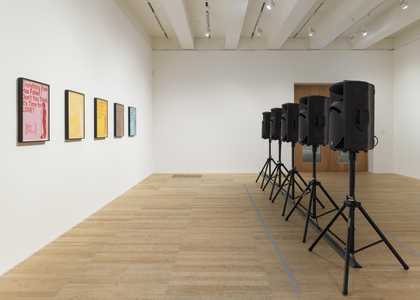
Sharon Hayes
Everything Else Has Failed! Don’t You Think It’s Time For Love? (2007)
Tate
Sharon Hayes’s work speaks to us in a more literal sense – aloud, and with words. Everything Else Has Failed! Don’t You Think It’s Time for Love? (2007) is an installation by Hayes that replays "love addresses". Hayes explains that a “love address” captures how she memorised and delivered these passages in the form of letters, as if they were composed on the spot. The installation comprises five PA speakers placed directly opposite five posters advertising the performance, one for each day of the week. From each speaker in turn, we hear Hayes’s amplified voice above the noise of a busy New York street, speaking to unnamed lover. In the original performance, Hayes stood on a busy corner outside an investment bank in Manhattan, speaking each "love address" aloud to the passing public, repeating each three times. In conversation with writer So Mayer, Hayes described how she wanted to “butch up” her appearance for the performance as she hoped the anonymised letters would be interpreted as expressions of queer love. But the “you” she addresses in the work remains an open invitation to whoever is listening.
Everything Else has Failed! Don't you Think it's Time for Love? is an installation by the American artist Sharon Hayes. Five loudspeakers arranged in a row in the centre of the room face five differently coloured A2 graphic posters also hung in a row on the wall. The loudspeakers and the images are installed facing each other as though they are in dialogue with one another The loudspeakers are mounted approximately one and a half metres from the floor on black stands.
In sequence each loudspeaker plays one of five audio recordings of spoken word performances by the artist. The room is filled with the recorded sound of the artist's voice, the busy ambience of the city and pedestrians passing by.
[Recorded voice]: It feels like an eternity since we've seen each other, since I heard your voice deep inside my head.
The artist has described the speakers as installed like a line of speaking bodies. The five A2 prints are portrait-orientated and hung at the same height as the loudspeakers. They are spray painted in the flat graphic style of DIY activist posters and mounted in modest thin black frames. Each print has two vivid contrasting colours, one for the background and the other for the text and image on top.
The title of the artwork printed in a bold headline font fills the top half of each print a smaller text in the lower left half of each print advertises the date and location of the performance. On the right side of each print there's a single silhouette of the artist standing with a microphone on a stand. In each print her stance and direction are slightly varied, from left to right the colours of the five prints are pink with red, yellow with white yellow with orange, brown with beige and light blue with dark blue
The audio recordings are of a series of performances the artist made in 2007 over five consecutive lunch times. The artist recited letters to unnamed lovers into an amplified microphone on the street outside a UBS investment bank in Manhattan.
[Recorded voice]: I started I started making scratch marks on the wood in the door jamb of the... between my my bedroom and my living room a mark for every day that you're gone but the days are so long and I'm not quite sure what to do with the day anymore except listen to the news and the news is so bad that somehow I found myself marking bombs instead of days and so now from my door jamb it seems like we've been apart for a half a year and every mark seems like it's a possible strike against you. But at least I know that if I find out many months from now that you were hurt or you were killed in September at least I know I was with you when it happened.
The letters are highly emotional and intimate fraught with despair desire and longing. She speaks about her sense of helplessness during the unfolding invasion and occupation of Iraq and Afghanistan, the trauma and dislocation of living in a moment of war as a U.S. citizen and feeling dislocated from her daily life. She narrates intimate details of her relationships with lovers through conversations and moments together, separations and distances. Aspects of these personal relationships begin to echo and reflect the intensely conflicted feelings she holds towards these broader political narratives
The title for this work was taken from a sign held by a protester in Berkeley in 1967.It is the first in a series of works she has called Love Addresses. These were made amidst a despairing feeling that mass street protests were unable to stop the US invasion of Iraq and Afghanistan.
The Love Addresses draw on archival material particularly slogans and placards from various liberation protests in the U.S such as Stonewall era gay rights protests where love functioned as a political tool. Hayes became involved with the performance scene in New York in 1991 in the middle of the AIDS crisis,
she has said this directly influenced her understanding that most aspects of our lives as queer people are political.
[Recorded voice]: People always say that in the moment of crisis the path of wisdom is far better than the path of emotion. At a point in every person's life one has to look deeply into the mirror of one's soul and decide one's unique truth in the world, not the way one wants it or the way one hopes it but the way it is and so my truth is that I am a gay American. This is an intensely personal decision one not typically meant for the public domain, but we shall not and cannot let it pass, I march in the parade of freedom but as long as I love you, I am not free.
In the letters she addresses her lovers directly as 'you' but there is nothing explicit in the text or installation to identify them. As listeners we can feel as though we could be directly addressed by these words. The artist has described "trying to reach someone specific by shouting into the wind so to speak". The letters do not specify the sexuality or gender of the writer or lover but Hayes has said "I butched myself up even more than usual because I didn't want the love to be read as heteronormative".
There is a contrast between the visual restraint of the materials in the installation and the emotionally evocative recital of the letters. Hayes has said in relation to her work "What if we were focused as much on hearing and speaking as on seeing?"
This audio description was written and recorded by Chris Timms.
The title of the work Everything Else Has Failed! Don’t You Think it’s Time for Love? is taken from a placard that was held up during a protest in Berkeley, California in 1967. Over the years, Hayes has amassed a large collection of photographs of protest signs containing the word “love”. For Hayes, the love expressed by these signs “is a commitment, a collective tactic, a vital component of [...] non-violent resistance.” In her work, Hayes uses the intimate language of a personal letter to a lover, but, like with the placards, the implications are different when they are shared publicly. “The letters are not being read to their [original] addressees but to imagined future audiences,” she explained.
“Everything else has failed! Don't you think it's time for love?” I found this image in a very general folder in the picture collection at the Mid Manhattan Library in New York City in probably the early 2000s. I have not seen images of it circulate elsewhere. The love here is not confident or clear. It does not enthusiastically recruit. It pleads. It's doubtful. It's vulnerable. I love it.
Sharon Hayes performing “What is Love?” presented as part of a Tate event with So Mayer.
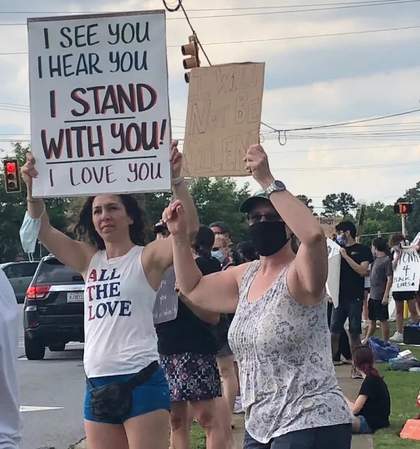
© Wendy Parker, East Cobb News, Georgia, USA
I see you. I hear you. I stand with you. I love you.
I, as the I who holds the sign, love you, who is not specified. You, who might be marching next to me, or passing by in your car, or walking by me and seeing this, or seeing this image on the internet.
Sharon Hayes performing “What is Love?” presented as part of a Tate event with So Mayer.
Everything Else Has Failed… is the first in a series Hayes calls Love Addresses, a series that speaks of Hayes’s despair and helplessness – and the failure of mass protest – in the face of the US war in Iraq and Afghanistan. She is interested in the idea that speech can do more than communicate, it can also perform “speech acts” (a theory developed by philosopher J.L. Austin in his 1962 book “How to do things with words”). Examples of speech acts include apologies, congratulations, invitations or promises, like the words “I do” during a marriage ceremony. I like to think Hayes’s work is a speech act of solidarity, of love. As with protest signs, art is an open invitation that can speak – and offer this act of love – to anyone who sees it. Hayes explained how to understand the address from a protest placard, you need to look at the words on the sign, the person holding it and the place and time they are in. Although referencing specific political events of 2007, as part of Tate’s collection, the work will now exist across time, preserved by the museum to perform speech acts at potentially infinite future moments.
I went towards love to talk about war, because to arrive on the street with a microphone and a speaker to talk about war did not feel possible actually. It did not feel possible in that moment. And so I do think of this work as a way to speak indirectly to a public or a set of publics that was right in front of me, walking by, but who weren't the literal addressee. So it allowed for a kind of way to sit or stand or listen from or absorb from a place of kind of ethical witnessing rather than from a place of being the “you” themselves.
Sharon Hayes in conversation with writer, film curator and organiser So Mayer at a Tate event
Trisha Brown
Speaking Through Movement
I often think of dance as an ephemeral performance, but its life is also prolonged when it enters a museum’s collection. Trisha Brown’s Set and Reset is a work of post-modern dance first performed in 1983. Brown originally choreographed the piece using a process of memorised improvisation. The improvisation was done to a set of five instructions from Brown: “keep it simple, act of instinct, stay on the edge, work with visibility and invisibility, and get in line”. Carolyn Lucas (Associate Artistic Director of Trisha Brown Dance Company) explained how dancers must learn a new vocabulary of dance in order to master the choreography, putting together memorised phrases of movement to create longer passages.
Trisha develops movement vocabulary. So she always starts with phrase work. And then she's thinking, What am I going to do with these phrases? And that's pretty much her motor through the trajectory of her career, it’s always to make the vocabulary first.
Carolyn Lucas in a Tate event panel discussion about Trisha Brown’s 1983 dance Set and Reset
Watching the performance, I feel like I am experiencing improvisation, full of the happy coincidences that occur when a group of people know each other so well that they are in tune with each other’s movements, like when you adopt a tilt of the head from your mother or an eyebrow raise from your best friend. In discussion with Carolyn Lucas, dancer Joel Brown and Director of Programme Catherine Wood, Benoit-Swan Pouffer (Artistic Director of Rambert) spoke about bodies being collectors of experiences. There is the physical memory of the dance choreography but also the memories of how the body has moved before, both through dance and in the world in general. The end performance expresses all of these experiences, this knowledge. In the original performance of the piece, we can compare the movement of Eva Karczag, a dancer who brought her traditional ballet training to her movement, to Trisha Brown, whose movements were deliberate refusals of ballet’s strict language.
I just do believe that the more [dancers] get into a work, the more [...] they immerse themselves in the work, they're going to leave with something. [...] It makes them richer. It makes them collectors and that’s what we all are as dancers.
Benoit Swan Pouffer in a Tate event panel discussion about Trisha Brown’s 1983 dance Set and Reset
The choreography speaks across generations to other communities of dancers. Dancer Joel Brown, who performs a version of Trisha Brown’s choreography called Set and Reset/Reset with Candoco Dance Company, spoke of his excitement that Set and Reset would be kept alive through new dancers who will need to learn the choreography every time the piece is brought out for “display”.
I feel a connection or a history or a shared knowledge with other people who also know this knowledge. But I have this fantasy of being a really old man in a wheelchair. And there’s hopefully some young dancers learning this work, and I just join them.
Joel Brown in a Tate event panel discussion about Trisha Brown’s 1983 dance Set and Reset
Gee’s Bend
Speaking Through Community
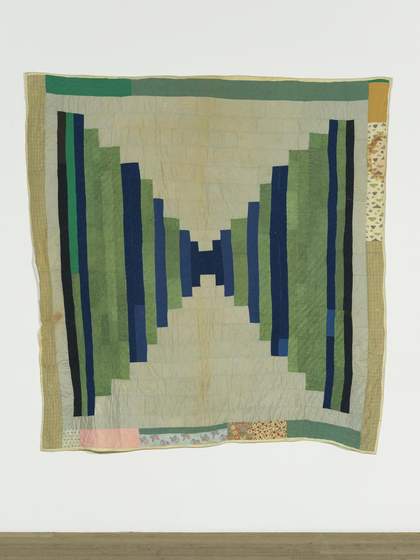
Aolar Mosely
“Log Cabin” - single block “Courthouse Steps” variation (local name: “Bricklayer”) (c.1950)
Lent by the Tate Americas Foundation 2022
In Gee’s Bend, Alabama, the skill of quiltmaking has been passed down through generations of African-American women since the 19th century. Seeing these quilts in a gallery, I am very aware that many were made to be used, not to be seen in the white cube of a contemporary art space. The quilts were traditionally taken outside after the winter months to be aired out and were laid over washing lines and fences to be examined and enjoyed by neighbours. They contain the material evidence of the mundane and everyday, of special memories and loved ones passed away. They make me think of the cloth that has held important places in my life – a blanket given to me by my nana, a t-shirt I kept for years after I outgrew it. A different kind of beauty is found in wear and in age, in something that has meant many different things to different people over its life and theirs.
Until the middle of the 20th century, the majority of patchwork quilts from the area were constructed from the remains of ragged shirts, dress bottoms and worn out denim work trousers. This is what we refer to as the work-clothes quilt. And in a way, these work-clothes quilts really provide a tangible record of lives lived in the community and is part of that kind of constancy of understanding of self, of community and also of history. There is something really profoundly autobiographical about these works. The ancestors are still there keeping you warm. They act as these extended family portraits, in a sense. In Gee's Bend, this recycling practice really became the founding ethos for generations of quiltmakers who have transformed this otherwise useless material into the marvels that we see now all around the world.
Raina Lampkins-Fielder in conversation with art historian and curator artist Alayo Akinkugbe about The Gee’s Bend quiltmakers at Tate event
Most quilts from Gee’s Bend can be considered “my way” quilts. Speaking with art historian Alayo Akinkugbe, curator Raina Lampkins-Fielder explained how “the quilter starts with basic forms and then heads off “their way”, allowing the material to really direct their hand with unexpected patterns, unusual colours, and surprising rhythms, really seeing where the quilt takes you”. There are also many popular quilt styles including “house top”, a pattern of concentric squares that begins with a medallion of solid cloth to which rectangular strips of cloth are added. Aolar Mosely’s quilt “Log Cabin” – single block “Courthouse Steps” variation (local name: “Bricklayer”) (c.1950) is a particular adaptation of the house top style, which in Gee’s Bend is called “bricklayer”. The quilt is hung like a painting in the gallery, but I imagine what it would be like to look down on it from above, like the aerial view of the housetop it depicts. I see the stains faded by time and imagine a time long ago, a clumsy child spilling a drink and scolded by their mother who had spent so long crafting together the scraps of material.
The quilts do not just reveal individual and family histories preserved in the materials but they also record the history of the community. The Freedom Quilting Bee was a sewing co-operative to which many of the Gee’s Bend quilters belonged. In 1972, Sears Roebuck, a nationwide retailer in the US, commissioned the co-operative to create corduroy pillow covers. You can now see this commercial enterprise reflected in the gold, avocado leaf, tangerine and cherry red corduroy used in many quilts around that time – offcuts and scraps from the commission that the women saved from the floor and shared with other quilters in the community.
The way that art has been and continues to be categorised can change the way it is received. Artists from Gee’s Bend have often been described as “self-taught”, a label Raina Lampkins-Fielder believes “doesn’t have a bearing on the work that these artists are producing.” The term self-taught not only affects the way that people perceive the art but also affects people’s ability to talk about it, giving the impression that this artform has sprung up from nowhere and has no relationship to the rest of art history.
[The term self-taught means that] work might not be shown in a museum in a certain way, that there might not be curators who are able to work with those works of art. They might not be written about. That information about these artists won't be disseminated as widely. [...] The fair market value of their work will be significantly diminished by all of these titles.
Raina Lampkins-Fielder in conversation with art historian and curator artist Alayo Akinkugbe about The Gee’s Bend quiltmakers at Tate event
End Thoughts
Writing this piece has allowed me to spend time with these works and reflect on how they speak to me personally and how that conversation relies on so much more than the artwork itself. There are many power structures at play that shape our perception of art, and influence where it is shown, how it is described, and even who is open to listening to it. The works by Lyle Ashton Harris, Sharon Hayes, Trisha Brown and the Gee’s Bend quiltmakers have sparked conversations between artists, historians, curators and dancers about how art can speak in today’s world. It’s exciting to think about how these artworks might generate new conversations with future generations, to speak in ways we can’t yet imagine.
About Debbie Meniru
Debbie Meniru is a London-based writer and curator who explores art and museums through emotion, anecdote and humour. Her writing has been published internationally and you can read more on her website.
The How Does Art Speak? Series is part of the Terra Foundation for American Art Series: New Perspectives

